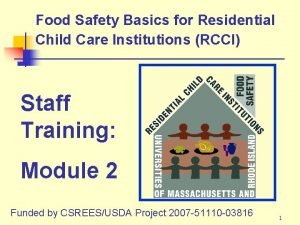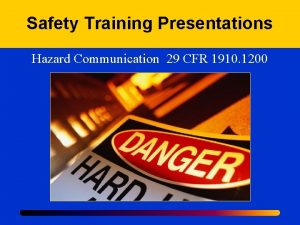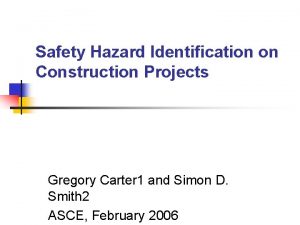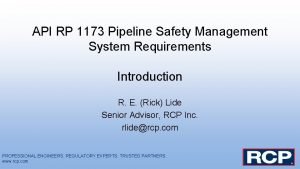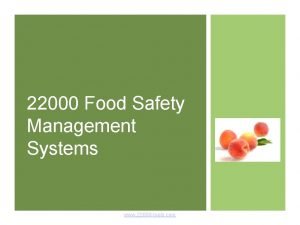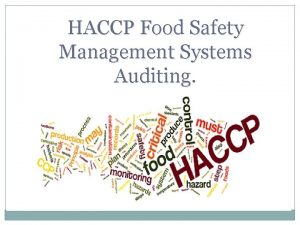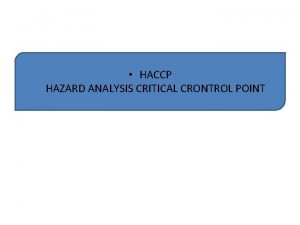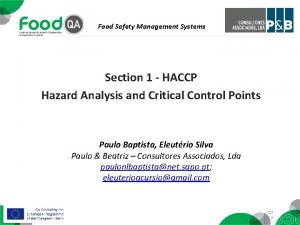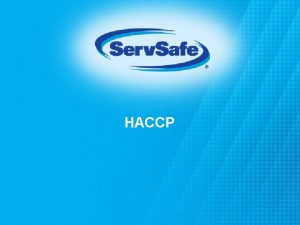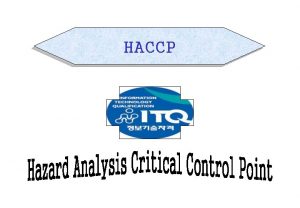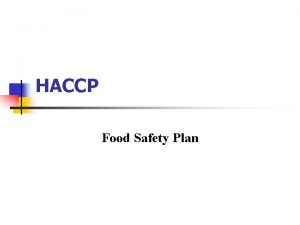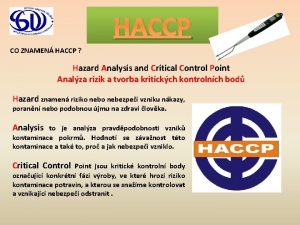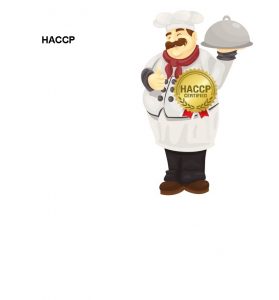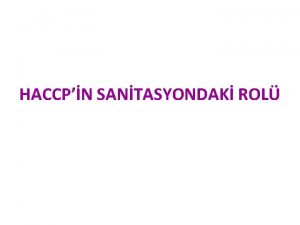Food Safety Management Systems Section 1 HACCP Hazard













- Slides: 13

Food Safety Management Systems Section 1 - HACCP Hazard Analysis and Critical Control Points Paulo Baptista, Eleutério Silva Paulo & Beatriz – Consultores Associados, Lda paulonlbaptista@net. sapo. pt; eleuterioacursio@gmail. com

Outline 1. 2. 3. 4. Introduction The concept of HACCP The principles of HACCP The HACCP methodology

Learning outcomes The trainee/student will: - Be able to understand the concept and principles of the HACCP System. - Be able to understand the methodology of implementation of a HACCP System, describing in detail the steps inherent in this process. - Be able to be involved in the implementation of HACCP methodology in companies, in particular in the steps related to hazard analysis, the determination of critical control points, the establishment of critical limits and the establishment of the monitoring system.

DISCUSSIONS / SOLUTIONS OF EVALUATION EXERCISES 4

Discussions / solutions of evaluation exercises Question no. 1 (40 points/100) The company produces fruit juices. One defined CCP is the pasteurization of the glass bottles after filling (pasteurization tunnel). Critical limits of the CCP are validated to be 5 minutes with 82ºC. Monitoring of the time/temperature is carried out continuously. Two test bottles, equipped with data loggers are additionally sent to through the pasteurization tunnel twice daily. During the factory tour the time /temperature monitoring of the CCP is checked and everything is according to the set limits but the test bottles could not be found. 5

Discussions / solutions of evaluation exercises Question no. 1 (40 points/100) Which of the following statement(s)/judgement(s) is/are correct? m The company has clearly identified the CCP and critical limits are established. m The company has clearly identified the CCP but the critical limits are not adequately established. m The company does not implement his own rules for the daily additional check of the pasteurization tunnel by test bottles equipped with data loggers. m Validation of CCP (time/temperature) is planned in a daily basis. 6

Discussions / solutions of evaluation exercises Question no. 2 (40 points/100) An audit takes place in a canned tuna fish factory in Thailand. The company has 110 staff workers and approximately 800 contract workers. The plant capacity is approximately 70 tons of tuna per day on 3 shift basis producing 6100 cases and a turnover of approximately 14 M€ per year. The company produces tuna (solid, chunks and flakes) in oil, brine and vegetable broth in both retail and catering can sizes. Raw materials are frozen and fresh skipjack and yellow fin tuna, salt, oil and vegetable broth. All preservation is by sterilization in horizontal steam retorts. 7

Discussions / solutions of evaluation exercises Question no. 2 (40 points/100) Production distribution is approximately 60% to America and 40% to Europe and the has EU registration mark. The HACCP system is based on the Codex Alimentarius principles and Codex decision tree for CCP identification. Different CCPs were defined e. g. double seaming, retorting, metal detection, histamine for incoming fish. Histamine was chosen as an additional CCP because it is an established food safety criterion for the raw material. During the factory tour the auditor observed that on that day histamine monitoring tests were not performed from the vessel hatches and during two other days of last week not at the prescribed batch sampling rate. 8

Discussions / solutions of evaluation exercises Question no. 2 (40 points/100) Which of the following statement(s)/judgement(s) is/are correct? m The company’s procedures on CCP monitoring of histamine was not complied with on one day. This failure it is not relevant. m The company’s procedures on CCP monitoring of histamine was not complied with on one day. This failure has significant risks in terms of food safety. m Histamine tests were not carried out at the point of discharge from vessels holds at the prescribed batch sampling rate. This is not significant because the sampling rate is selected by the company. m The company procedure on CCP definition is based in Codex Alimentarius. Nevertheless the company choose histamine as CCP because of being a food safety criterion. This lacks logical approach. 9

Discussions / solutions of evaluation exercises Question no. 3 (20 points/100) In a company, the metal detection check procedure states that checks have to be done with ferrous, non-ferrous and stainless test pieces at the beginning and end of the production, at least every 2 hours and after breaks. On metal record checks, it can be observed the following information: date of checks (without time mentioned), if the test results are conform or not (without specifying for which test pieces), name of the persons working on the line (but not the name of the person responsible for the check). The metal record checks are appropriate? Justify. 10

References AFNOR, Norme expérimentale XP V 01 -003 – Lignes Directrices pour l’Elaboration d’un Protocole de Validation de la Durée de Vie Microbiologique, AFNOR – Association Française de Normalisation, Paris, France, 1998. Baptista, P. e Noronha, J. , Segurança Alimentar em Estabelecimentos Agro-Alimentares: Projecto e Construção, Forvisão – Consultoria em Formação Integrada, Guimarães, Portugal, 2003. Baptista, P. e Saraiva, J. , Higiene Pessoal na Indústria Alimentar, Forvisão – Consultoria em Formação Integrada, Guimarães, Portugal, 2003.

References Baptista, P. e Venâncio, A. , Os Perigos para a Segurança Alimentar no Processamento de Alimentos, Forvisão – Consultoria em Formação Integrada, Guimarães, Portugal, 2003. Baptista, P. , Higiene e Desinfecção de Equipamentos e Instalações na Indústria Agro-Alimentar, Forvisão – Consultoria em Formação Integrada, Guimarães, Portugal, 2003. CAC, CAC/GL 021 -1997 – Principles for the Establishment and Application of Microbiological Criteria for Foods, CAC Comissão do Codex Alimentarius, 1997.

References CAC, CAC/GL 030 -1999 – Principles and Guidelines for the Conduct of Microbiological Risk Assessment, CAC - Comissão do Codex Alimentarius, 1999 b. CAC, CAC/RCP 1 -1969, Rev. 3, Amd. 1 - General Principles of Food Hygiene, CAC - Codex Alimentarius Commission, 1999 a. Gilbert, R. J. , Louvois, J. , Donovan, T. , Little, C. , Nye, K. , Ribeiro, C. D. , Richards, J. , Roberts, D. , Bolton, F. J. , 2000, Guidelines for the microbiological quality of some ready-to-eat foods sampled at the point of sale, PHLS Advisory Committee for Food and Dairy Products, Communicable Disease and Public Health, 3 (3): 163 -7.
 Food safety management systems servsafe chapter 8 notes
Food safety management systems servsafe chapter 8 notes Food safety food security
Food safety food security Residential child care institutions
Residential child care institutions Hazard communication safety training quiz answers
Hazard communication safety training quiz answers Safety hazard identification on construction projects
Safety hazard identification on construction projects Hazard based safety engineering
Hazard based safety engineering Unit 2 food food food
Unit 2 food food food Food chain sequence
Food chain sequence Api rp 1173
Api rp 1173 4 food chains
4 food chains Physical hazards
Physical hazards Food safety management system template
Food safety management system template Iso 22000 tools
Iso 22000 tools Objectives of haccp
Objectives of haccp


